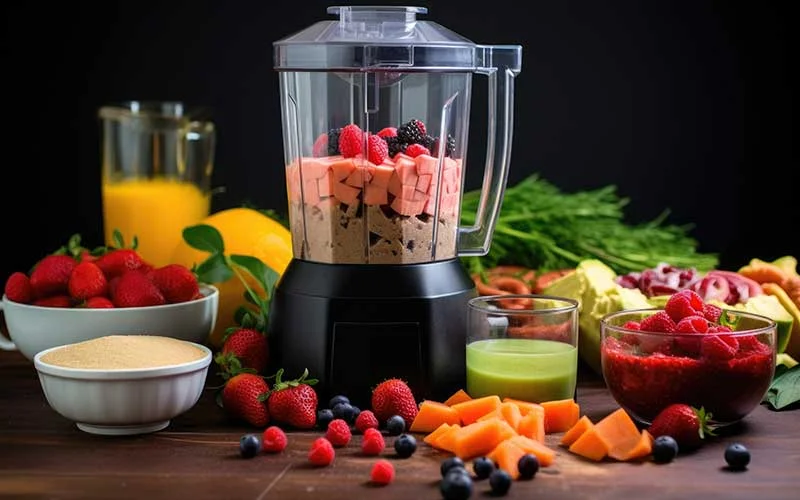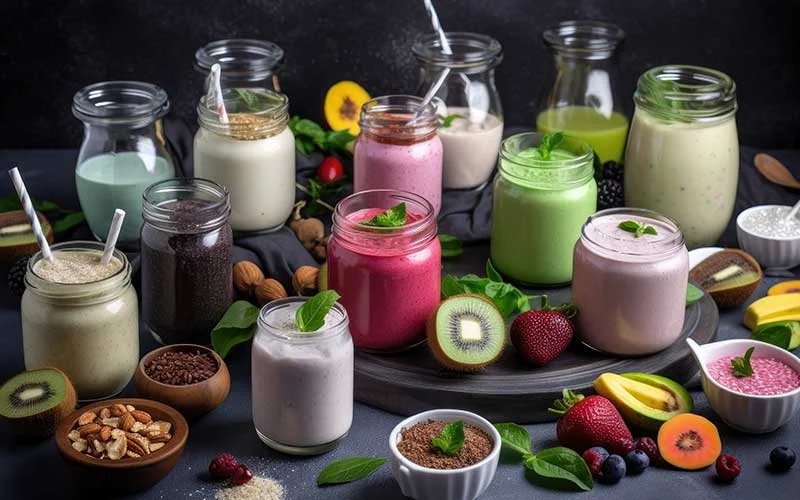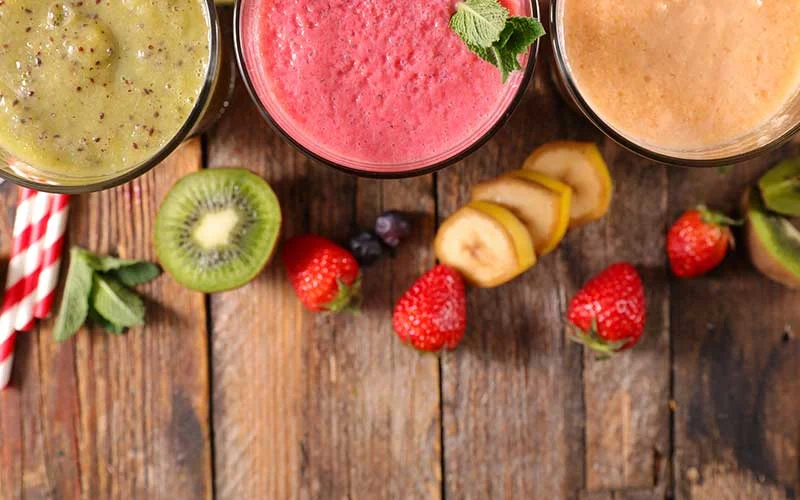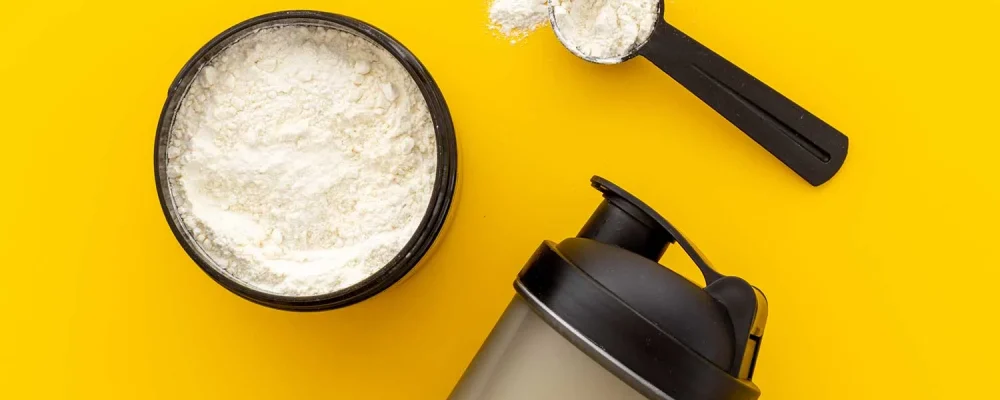In today’s fast-paced world, many of us struggle to eat healthy due to our busy lives. Meal replacement shakes have become a convenient solution, offering a quick and balanced meal alternative. But there’s a question: should you buy ready-made commercial shakes or make your own at home?
In this guide, we’ll explore the pros and cons of both DIY and commercial meal replacement shakes. We’ll dig into the nutrition, taste, cost, customization, convenience, health factors, and expert advice to help you decide which option suits you best.
DIY Meal Replacement Shakes

DIY or home made meal replacement shakes have gained popularity because you can control the ingredients and tailor them to your preferences. It’s as simple as blending a few things in your kitchen.
When making DIY shakes, it’s essential to pick a mix of protein, carbs, healthy fats, vitamins, and minerals. Ingredients like protein powder, fruits, veggies, nuts, seeds, and yogurt can be adjusted to your taste and nutritional needs.
Commercial Meal Replacement Shakes
Commercial shakes are easily available in stores and online, making them a quick option for busy folks. These shakes are carefully crafted to provide balanced nutrients, making them a convenient choice.
Commercial shakes come in different flavors and are packed for easy consumption. They cater to specific dietary needs, whether it’s weight loss, muscle gain, or general nutrition, making them versatile [1].
Nutritional Comparison
One of the biggest factors in choosing DIY or commercial shakes is their nutrition. Let’s compare them in terms of nutrition.
| Aspect | DIY Meal Replacement Shakes | Commercial Meal Replacement Shakes |
| Nutritional Variation | Varies depending on ingredients | Usually formulated for balance |
| Macronutrient Control | You have control | Typically balanced |
| Customization | Customizable to dietary needs | Limited customization options |
| Research Required | May require research | Ready-made for convenience |
| Convenience | Time-consuming to prepare | Quick and convenient |
| Additives and Preservatives | Depends on ingredients | May contain artificial additives |
| Nutritional Quality | Depends on recipe and choices | Quality varies between brands |
Are DIY Meal Replacement Shakes As Nutritionally Balanced As Commercial Ones?

The balance of nutrients in DIY shakes depends on what you put in them. While they offer flexibility, you need to understand nutrition and ingredient selection to make sure they’re balanced. You can consult a registered dietitian for help.
Commercial shakes are designed to be balanced from the start. They’re created by experts who consider daily nutrient recommendations. But remember, not all brands are the same, so read labels and pick reputable ones [2].
How Can I Ensure That DIY Meal Replacement Shakes Meet My Specific Dietary Needs?
DIY shakes are fantastic for catering to your unique dietary needs or restrictions. To make sure they meet your requirements:
Consult a dietitian: Get advice from a registered dietitian who can help you create a shake recipe that aligns with your goals.
Use quality ingredients: Choose fresh, whole foods and good supplements to ensure you get the nutrients you need.
Measure ingredients: Use measuring cups or a scale to maintain consistency and the right nutrient ratios.
Track intake: Keep a food diary to monitor nutrient intake and adjust as needed.
Do Commercial Meal Replacement Shakes Contain Artificial Additives and Preservatives?
Many commercial shakes have artificial additives and preservatives to extend shelf life and enhance flavor. Some people prefer to avoid these for personal reasons or health concerns.
If you’re worried about artificial stuff, read labels. Some brands offer options with fewer or no artificial additives. Going organic or plant-based can also reduce artificial additives.
Are There Any Safety Concerns with DIY Meal Replacement Shakes, such as Contamination or Improper Ingredient Proportions?
Safety is crucial when making DIY shakes. Here are some safety concerns and tips:
Clean ingredients: Wash everything, especially produce, to prevent contamination.
Store right: Keep ingredients clean and hygienic to avoid spoilage or contamination.
Measure correctly: Be careful when measuring to keep the right nutrient balance.
Clean the blender: After each use, clean your blender well to prevent harmful bacteria.
Follow safety guidelines: Learn food safety to reduce the risk of illnesses.
Which Option Is More Cost-effective In The Long Run, DIY or Commercial Meal Replacement Shakes?
Cost is a big deal for many when choosing between DIY and commercial shakes. Let’s look at the long-term costs.
| Aspect | DIY Meal Replacement Shakes | Commercial Meal Replacement Shakes |
| Initial Cost | Might cost more initially due to buying various ingredients. | Usually, they have a consistent cost per serving. |
| Long-Term Cost | Over time, you can save money by buying in bulk and minimizing waste. | May seem cheaper short-term but add up over time. |
| Customization | You can control expenses with ingredient choices. | Limited customization can lead to extra spending on other dietary needs. |
Cost-effectiveness depends on your preferences, how often you use shakes, and your budget. Consider ingredient availability, quality, and frequency when deciding.
Customization and Dietary Preferences

Customization is a massive advantage of DIY shakes, letting you tailor them to your needs.
DIY Meal Replacement Shakes
- You choose ingredients that match your goals (vegan, paleo, keto).
- Personalize flavors to your liking.
- Adjust nutrient ratios as needed.
Commercial Meal Replacement Shakes
- Limited customization compared to DIY.
- Come in different flavors and formulations but might not cater to all diets.
- Some brands offer special options for specific preferences.
If you have unique dietary needs, DIY shakes give you complete control. But commercial options keep growing to suit a wider range of diets.
Convenience and Time Efficiency
When it comes to convenience and time, commercial shakes have the edge.
DIY Meal Replacement Shakes
- Need time for prep, measuring, and blending.
- Can involve multiple ingredients, taking more time.
- Good for those who enjoy making meals from scratch.
Commercial Meal Replacement Shakes
- Ready to drink, no prep.
- Ideal for busy people or those with no access to a kitchen.
- Handy for on-the-go.
If you value convenience and need quick meals, commercial shakes are the way to go. DIY is great if you have time and enjoy creating your own recipes.
Health Considerations
Your health should be a top concern when picking between DIY and commercial shakes. Here’s what to think about:
DIY Meal Replacement Shakes
- You control ingredient quality and source.
- Can use whole, unprocessed foods and organic stuff.
- Requires nutrition knowledge and ingredient choices for balance.
Commercial Meal Replacement Shakes
- May have artificial additives and preservatives.
- Quality varies between brands.
- Convenient but might not align with all health-conscious folks.
If you’re a health nut, both DIY and commercial options can work. DIY gives you total ingredient control, while some brands offer healthier, natural choices.
Consulting Experts for Guidance
To make an informed choice between DIY and commercial shakes, consider seeking advice from experts like registered dietitians, nutritionists, or healthcare pros.
Registered Dietitians
- Can assess your dietary needs and goals.
- Give personalized DIY or commercial shake suggestions.
- Help with ingredient selection and portion control.
Nutritionists
- Offer general dietary advice and recommendations.
- Can give insights on meal replacement shakes but not personalized guidance.
Healthcare Professionals
- Talk to your healthcare provider if you have medical conditions or dietary restrictions.
- They can suggest dietary choices that match your health needs.
FAQs
Are DIY Meal Replacement Shakes As Nutritionally Balanced As Commercial Ones?
DIY shakes can be as nutritionally balanced as commercial ones if you pick and measure ingredients wisely. To ensure balance, consult a dietitian or use reputable recipes that guide ingredient proportions.
How Can I Ensure That DIY Meal Replacement Shakes Meet My Specific Dietary Needs?
To make DIY meal shakes that fit your diet, talk to a diet expert, use good ingredients, balance your foods, follow the recipes carefully, and keep an eye on your nutrients. Change your shakes if you need to and consider vitamins if it’s necessary. Look at your shakes from time to time to match your food goals.
Do Commercial Meal Replacement Shakes Contain Artificial Additives and Preservatives?
Many commercial shakes have artificial additives and preservatives for flavor and shelf life. If you want to dodge these, read labels. Some brands offer options with fewer or no artificial additives. Going organic or plant-based can also help.
Are There Any Safety Concerns with DIY Meal Replacement Shakes, like Contamination or Bad Ingredient Proportions?
Yes, there can be safety concerns with DIY meal replacement shakes. Contamination is a worry if ingredients aren’t handled or stored properly. Bad ingredient proportions can lead to an unbalanced and potentially unhealthy shake. It’s crucial to maintain cleanliness, measure ingredients accurately, and follow safety guidelines to ensure the safety of your DIY shakes.
Which Option Is More Cost-effective in the Long Run, DIY or Commercial Meal Replacement Shakes?
The cost-effectiveness of DIY vs. commercial shakes depends on factors like ingredient quality, how often you use them, and your budget. While DIY shakes might cost more at first, you can save over time by buying in bulk and reducing waste.
Final Thoughts
In the end, choosing between DIY and commercial meal replacement shakes comes down to your lifestyle, tastes, health goals, and budget. DIY shakes offer freedom and customization but need time and nutrition knowledge. Commercial shakes are quick and have a consistent profile but may have artificial stuff.
To make the best call, think about your needs and talk to experts like dietitians or healthcare pros. No matter your choice, meal replacement shakes can help you maintain a healthy diet when life gets hectic, keeping you on track with your wellness goals.
Source
[1] Noronha, J. C., Kendall, C. W., Sievenpiper, J. L. (2022). Meal Replacements for Weight-Related Complications in Type 2 Diabetes: What Is the State of the Evidence?. Frontiers in Endocrinology, 13, 875535. https://doi.org/10.3389/fendo.2022.875535
[2] Childs, J. L., Thompson, J. L., Lillard, J. S., Berry, T. K., Drake, M. (2008). Consumer perception of whey and soy protein in meal replacement products. Journal of sensory studies, 23(3), 320-339. https://doi.org/10.1111/j.1745-459X.2008.00158.x
[wptb id=5842]
RV Team
* Reviewology is in partnership or collaborates with top brands highlighted on this site, including those occupying the top ranking positions.
Additionally, we earn affiliate commissions from products showcased on this website when you make a purchase through the provided links on Amazon or the company website directly.
We appreciate your support using our links to purchase your favorite brands or newly discovered brands.
Latest updates
I Thought I’d Always Feel Tired, Fat, and Forgotten—Until This
310 Greens vs AG1
The Truth About 310 Greens: A No-Nonsense Review of This Popular Supplement
Popular
I Thought I’d Always Feel Tired, Fat, and Forgotten—Until This
310 Greens vs AG1
The Truth About 310 Greens: A No-Nonsense Review of This Popular Supplement
© 2024 Reviewology. All Rights Reserved.
